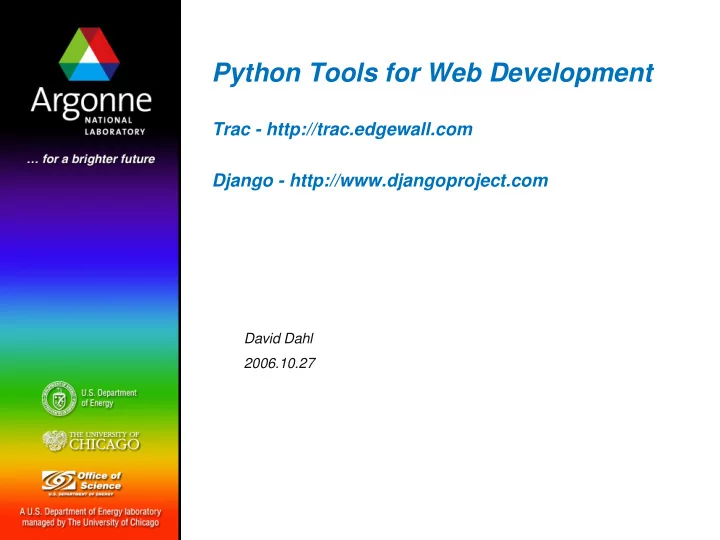

Python Tools for Web Development Trac - http://trac.edgewall.com Django - http://www.djangoproject.com David Dahl 2006.10.27
Intro There are many tools written in Python that help developers get organized and write web applications quickly. Trac is a Project Management Tool that interfaces with Subversion Django is a “Web Framework” that helps developers create flexible, scalable and maintainable applications. 2
What is Trac? Project Management System Ties neatly into SVN revision control Can be used for software project management Can be used for general project management 3
Who uses Trac? NASA's Jet Propulsion Laboratory – http://www.jpl.nasa.gov/ -- “We use Trac & SVN to manage various deep-space and near-space projects.” EECS Department of Case Western Reserve University – http://www.eecs.cwru.edu/ -- “We provide Trac and Subversion to all of the computer science students (and anyone else interested).” Hybrid Perception – http://www.hybridperception.com -- We use Trac internally for three major projects and for many one-to-one or many-to-many customer relationship management. Trac allows to show our customers realtime achievement of their projects and up to the second interaction with them. We also integrate it on some of our customers' development platforms. Excerpted from: http://trac.edgewall.org/wiki/TracUsers 4
Key Trac Features Wiki Roadmap Timeline Tickets 5
Wiki Familiar WikiWord usage Dovetails with Trac Ticket, Report and source code revision systems – Example: Tickets: #1 or ticket:1 will result in the following display: Tickets: #1 or ticket:1 6
7
8
Roadmap High level overview of project status Display groups of tickets as “Milestones” 9
10
11
12
Timeline Displays all wiki edits and source code changes 13
14
15
Tickets Individual tasks that make up a “Milestone” “Canned” or Customizable reports RSS feeds 16
17
18
19
20
Questions, Comments about Trac? 21
What is Django? Web Framework Supports Postgresql, MySQL, SQLite, Oracle, other database servers Clean Separation of Model, Template, View MVC vs. MTV 22
Who uses Django? Washington Post – http://washingtonpost.com – WP hired the creator of Django, Adrian Holovaty Tabblo – http://www.tabblo.com/ – Photo sharing site Chicago Crime – http://chicagocrime.org – RSS feeds of crime in your neighborhood 23
Key Django Features Well designed ORM (Object-relational mapper) – “inspectdb” reverse-engineering existing database schema Easy and Powerful Templating – Inheritance of templates Automatic Admin Interface RSS is nearly automatic Clean URLs Built-in development server 24
Django ORM – Database API Create a class for each table in models.py: class Switch(models.Model): switch_ip = models.CharField(maxlength=128) switch_name = models.CharField(maxlength=50) switch_type = models.CharField(maxlength=20) switch_manufacturer = \ models.ForeignKey(Manufacturer) class Manufacturer(models.Model): company = models.CharField(maxlength=128) 25
Using models Simple Fetch: sw = Switch.objects.get(77) Create a Switch: mnfctr = Manufacturer(company=”Cisco”) mnfctr.save() sw = Switch(switch_ip = “10.0.1.23”, switch_name=”switch.net.anl.gov”, switch_type=”leaf”, manufacturer=mnfctr) sw.save() Get or Create: mnfctr = Manufacturer.objects.get_or_create(company=”Cisco”) 26
Views: not the template! “Views” in Django are not Templates, they are Controllers (in any other MVC-type environment) A view is a view of the data that you have prepared to apply to the template: def index(request): hw = “Hello World” return render_to_response('index.html',{'hello':hw}) 27
Templates Base Template : <!DOCTYPE html PUBLIC "-//W3C//DTD XHTML 1.0 Transitional//EN" "http://www.w3.org/TR/xhtml1/DTD/xhtml1-transitional.dtd"> <html xmlns="http://www.w3.org/1999/xhtml" xml:lang="en" lang="en"> <head> {% block title %} <title>Switch Database</title> {% endblock %} <LINK HREF="/media/css/base.css" REL="stylesheet"> {% block js %} <SCRIPT SRC="/media/js/switchlib.js"></SCRIPT> {% block mochi %} <SCRIPT SRC="/media/js/MochiKit/MochiKit.js"></SCRIPT> {% endblock %} {% block dojo %} <SCRIPT SRC="/media/js/dojo/dojo.js"></SCRIPT> {% endblock %} ... etc... 28
Hello World Template {% extends “base.html” %} {% block title %} <title>Hello World</title> {% endblock %} {{ hello }} ############# View Code ############## def index(request): hw = “Hello World” return render_to_response('index.html',{'hello':hw} 29
Urls.py: Designing Your Urls with regex patterns urlpatterns = patterns('hw.views', (r'^$', 'index'), (r'^helloworld/$', 'index'), (r'^helloworld/this/is/long/$','index'), (r'^news_item/(?P<news_id>\d+)/$','news_item'), ) 30
Django Live Demo Admin Interface InspectDB JSON/Javascript/AJAX 31
Questions, Comments about Django? 32
Recommend
More recommend